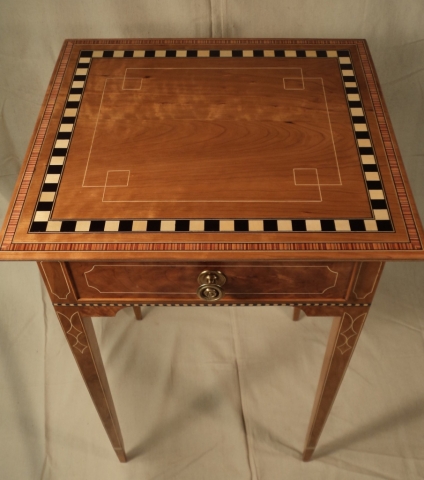William Francis Brown
in Forest, VA.
My furniture is hand made in my small shop in rural Virginia.
I grew up on a tree farm in Chester County, PA (Sam Brown Nursery in Willistown) and served a two year apprenticeship with E. Townsend Moore, a cabinetmaker who had been a curator at Dupont's Wintertur Estate and Museum outside Wilmington, Delaware. He learned from Robert Treat Hogg who was part of the two centuries long legacy of Chester County fine furniture makers. Chester County furniture developed a unique style that stemmed largely from the 17th century Welsh Quaker settlers. Certain design features include use of line and berry holly inlay, paneled chests, and wonderful William & Mary detail. I use almost exclusively (except for painted pine and windsor chairs) the abundant and traditional local hardwoods cherry, maple, and walnut. The Philadelphia makers, two hours ride to the East, were producing some of the finest furniture in the world, and that has been another strong influence on my highly carved rococo pieces.
I've been making and learning about period furniture for over 30 years. My pieces have been selected for museums and historic sites, including James Madison's Montpelior and Historic Jamestown. Rather than exact precise duplications, I prefer to make what I call 'historically informed' pieces. Unless requested by a museum, my furniture is not an exact reproduction, but will incorporate design elements and joinery that would have been common in the 18th and 19th centuries and make it my own. I continue to scour museum archives and study originals for ideas: patterns, moldings, inlay designs, proportions. I enjoy sketching details of the Chester County pieces I see in homes and exhibits in my home area. I think that one develops a trained eye. So that's how I make a piece; the result is representative of what an 18th century maker might produce but each piece will be my own, functional, and truly one of a kind.
It can take 6 months or more to make a piece, depending on the complexity and amount of carving, etc. I use exclusively the old tried and true dovetail and mortise & tenon joints which are cut by hand, not by jigs or machines. The right look cannot be matched by machines. Surfaces are hand planed and hand scraped, resulting in subtle variations that reflect light, which is what we so value in the original pieces. This is all highly labour intensive, but well appreciated by those who understand beautiful furniture.
I use oils for most of my finishes. Linseed and other natural oils can create a dazzling "pop" of the grain, especially with figured wood. I like General Finishes brand dyes for figured maple, and typically end with many thin coats of rubbed shellac or a silky smooth General Finishes varnish for more protection on a table top. The key to my study of finishing has been to maximize the natural character of the wood, create a hand-made texture and chatoyance, whilst avoiding the plastic look common to mass produced furniture. My furniture not only last generations, but will age well gracefully, gaining the lovely patina of our favourite antique originals.
Visit Facebook



